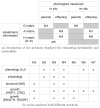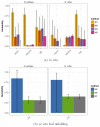In situ estimation of genetic variation of functional and ecological traits in Quercus petraea and Q.robur
- PMID: 32256274
- PMCID: PMC7136077
- DOI: 10.1007/s11295-019-1407-9
In situ estimation of genetic variation of functional and ecological traits in Quercus petraea and Q.robur
Abstract
Background: Predicting the evolutionary potential of natural tree populations requires the estimation of heritability and genetic correlations among traits on which selection acts, as differences in evolutionary success between species may rely on differences for these genetic parameters. In situ estimates are expected to be more accurate than measures done under controlled conditions which do not reflect the natural environmental variance.
Aims: The aim of the current study was to estimate three genetic parameters (i.e. heritability, evolvability and genetic correlations) in a natural mixed oak stand composed of Quercus petraea and Quercus robur about 100 years old, for 58 traits of ecological and functional relevance (growth, reproduction, phenology, physiology, resilience, structure, morphology and defence).
Methods: First we estimated genetic parameters directly in situ using realized genomic relatedness of adult trees and parentage relationships over two generations to estimate the traits additive variance. Secondly, we benefited from existing ex situ experiments (progeny tests and conservation collection) installed with the same populations, thus allowing comparisons of in situ heritability estimates with more traditional methods.
Results: Heritability and evolvability estimates obtained with different methods varied substantially and showed large confidence intervals, however we found that in situ were less precise than ex situ estimates, and assessments over two generations (with deeper relatedness) improved estimates of heritability while large sampling sizes are needed for accurate estimations. At the biological level, heritability values varied moderately across different ecological and functional categories of traits, and genetic correlations among traits were conserved over the two species.
Conclusion: We identified limits for using realized genomic relatedness in natural stands to estimate the genetic variance, given the overall low variance of genetic relatedness and the rather low sampling sizes of currently used long term genetic plots in forestry. These limits can be overcome if larger sample sizes are considered, or if the approach is extended over the next generation.
Keywords: Heritability; evolvability; genetic correlation; genomic relatedness; natural population; tree.
Conflict of interest statement
Conflict of interest disclosure The authors of this preprint declare that they have no financial conflict of interest with the content of this article.
Figures







Similar articles
-
How does contemporary selection shape oak phenotypes?Evol Appl. 2020 Aug 14;13(10):2772-2790. doi: 10.1111/eva.13082. eCollection 2020 Dec. Evol Appl. 2020. PMID: 33294022 Free PMC article.
-
Development of Target Sequence Capture and Estimation of Genomic Relatedness in a Mixed Oak Stand.Front Plant Sci. 2018 Jul 13;9:996. doi: 10.3389/fpls.2018.00996. eCollection 2018. Front Plant Sci. 2018. PMID: 30057586 Free PMC article.
-
Fine-scale species distribution changes in a mixed oak stand over two successive generations.New Phytol. 2017 Jul;215(1):126-139. doi: 10.1111/nph.14561. Epub 2017 Apr 26. New Phytol. 2017. PMID: 28444962 Free PMC article.
-
Seeing the forest through the trees: comprehensive inference on individual mating patterns in a mixed stand of Quercus robur and Q. petraea.Ann Bot. 2013 Aug;112(3):561-74. doi: 10.1093/aob/mct131. Epub 2013 Jun 19. Ann Bot. 2013. PMID: 23788747 Free PMC article.
-
Folic acid supplementation and malaria susceptibility and severity among people taking antifolate antimalarial drugs in endemic areas.Cochrane Database Syst Rev. 2022 Feb 1;2(2022):CD014217. doi: 10.1002/14651858.CD014217. Cochrane Database Syst Rev. 2022. PMID: 36321557 Free PMC article.
Cited by
-
Evaluating the effect of stand properties and site conditions on the forest reflectance from Sentinel-2 time series.PLoS One. 2021 Mar 15;16(3):e0248459. doi: 10.1371/journal.pone.0248459. eCollection 2021. PLoS One. 2021. PMID: 33720961 Free PMC article.
-
Integrating genomic information and productivity and climate-adaptability traits into a regional white spruce breeding program.PLoS One. 2022 Mar 17;17(3):e0264549. doi: 10.1371/journal.pone.0264549. eCollection 2022. PLoS One. 2022. PMID: 35298481 Free PMC article.
-
Low but significant evolutionary potential for growth, phenology and reproduction traits in European beech.Mol Ecol. 2025 Aug;34(16):e17196. doi: 10.1111/mec.17196. Epub 2023 Nov 14. Mol Ecol. 2025. PMID: 37962106 Free PMC article.
-
Counter-gradient variation of reproductive effort in a widely distributed temperate oak (Quercus petraea).Funct Ecol. 2021 Aug;35(8):1745-1755. doi: 10.1111/1365-2435.13830. Funct Ecol. 2021. PMID: 36825207 Free PMC article.
-
The GenTree Platform: growth traits and tree-level environmental data in 12 European forest tree species.Gigascience. 2021 Mar 18;10(3):giab010. doi: 10.1093/gigascience/giab010. Gigascience. 2021. PMID: 33734368 Free PMC article.
References
-
- Bacilieri R, Ducousso A, Kremer A. Comparison of morphological characters and molecular markers for the analysis of hybridization in sessile and pedunculate oak. Annales des Sciences Forestieres. 1996;53:79–91.
-
- Bacilieri R, Labbe T, Kremer A. Intraspecific genetic structure in a mixed population of Quercus petraea (Matt.) Leibl and Q. roburL. Heredity. 1994;73:130–141.
Grants and funding
LinkOut - more resources
Full Text Sources
